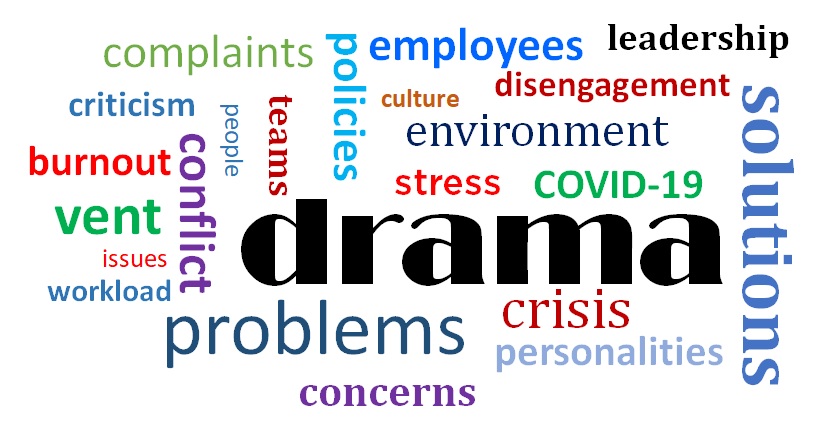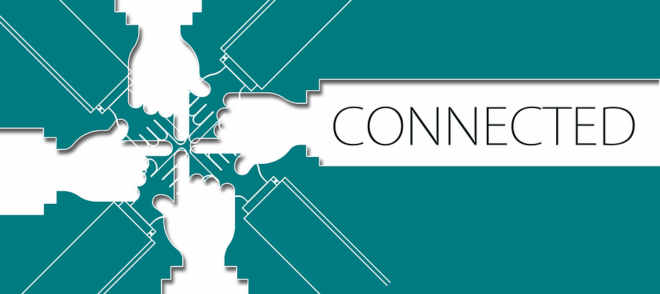In every organization there is a certain amount of “office drama.” In fact, studies show that, on average, employees spend about 2 hours a day on drama – conflict with other employees, grumbling about leaders, expressing frustration about work assignments or company policies, etc.
And it should come as no surprise that office drama has increased this year. There are several contributing factors:
- Organizations are asked to do more with less
- As employees work from home the lines are blurred between work and home life
- A national sense of aggressiveness is flowing down into the workplace
So how do you lead through the drama during this challenging time? And how do you disarm those who prefer to live in the drama even in the best of times?
I recently attended a (virtual) presentation entitled, “Reality-Based Leadership – How to Peacefully and Effectively Lead Teams Through Transformative Times.” The facilitator was Alex Dorr, Vice President of People Evolution at Reality-Based Leadership.
Here are some key takeaways from that session that I think are valuable for every leader to consider.
Employee engagement is more critical than ever. About 70% of employees are quitting their jobs in their mind every day. They’re not actually quitting – yet. But the fact that they’re thinking about it means they are less engaged and more likely to get caught up in employee drama.
Complaining increases endorphins. Think about it. When you vent or “let off steam” by dumping your problems or issues on someone else you feel better. And it’s much easier than coming up with a solution and taking action.
Help employees be self-reflective. When employees come to you with problems or complaints, encourage them to envision a solution. First let them vent. Then let them know you heard them. Then ask, “What would an acceptable solution look like?” Put on your coaching hat and ask questions to help them be part of the solution.
Use the SBAR approach. (Situation, Background, Analysis, Recommendation). Teach employees that if they have a concern or want change, before they come to you, they should have an SBAR. This is a short statement that describes the situation (S) and explains why it is happening now and how it needs to look different in the future (B). It also includes best practices, data, and policies that provide insight and support the change (A). And finally, it includes 2 or 3 recommendations (R) that the employee proposes.
Discover your desired role – as leader. Don’t jump in with an immediate solution. Ask questions – coach – to make this a development opportunity and clarify the role the employee wants you to play. Ask: How do you want me to help? Just listen? Help you think through each of your recommendations? Make additional recommendations?
Gain commitment. Whatever you decide to do to move forward, make sure that both of you – leader and employee – are clear on what the commitment is before leaving the meeting.
Model the behavior. Don’t be part of the drama. Demonstrate that you also take time for self-reflection and that you are capable of just stepping back and letting employees take action to create their own solutions.
If you have leaders who tend to get caught up in the drama, executive coaching can be helpful. Please contact me at michelle@connecttohr.com.




 about their customers, about their community – significantly outperform their less-caring peers. People want to work there. Customers want to buy there. And they all want to tell their friends.
about their customers, about their community – significantly outperform their less-caring peers. People want to work there. Customers want to buy there. And they all want to tell their friends. Over the past few months I’ve been talking about the skills required to be an effective leader. So far I’ve talked about listening, self-awareness and conversational intelligence. Another skill that is being increasingly recognized as an essential leadership skill is empathy. Although we’re not seeing it demonstrated much on the national stage, empathy has been called THE skill for the 21st Century.
Over the past few months I’ve been talking about the skills required to be an effective leader. So far I’ve talked about listening, self-awareness and conversational intelligence. Another skill that is being increasingly recognized as an essential leadership skill is empathy. Although we’re not seeing it demonstrated much on the national stage, empathy has been called THE skill for the 21st Century.


